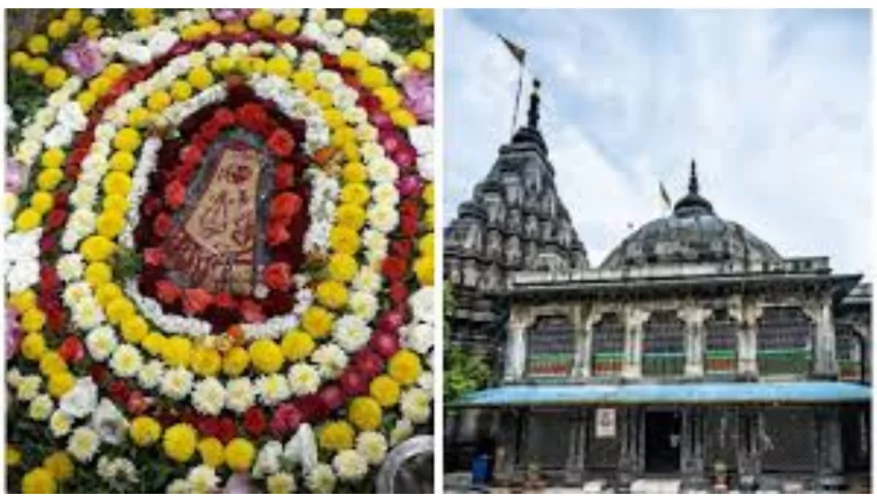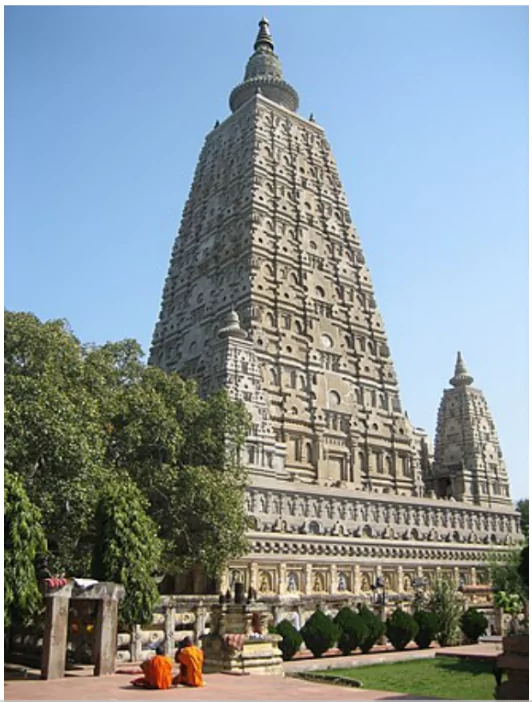In the Union Budget of 2024, Corridor Projects were announced for the Vishnupad Temple at Gaya and the Mahabodhi Temple at Bodh Gaya in Bihar.
- The project will be modelled on the successful Kashi Vishwanath Temple Corridor, aiming to transform them into world-class pilgrim and tourist destinations.
- The two temples are located around 10km from each other
About The Vishnupad Temple at Gaya

- Presiding Deity: Lord Vishu.
- Location: It is situated on the banks of the Phalgu river in Gaya district of Bihar, India.
- Built by: The temple was built in 1787 on the orders of Queen Ahilyabai Holkar of Ahmadnagar.
- Architecture: The temple is around 100 feet tall and has 44 pillars built of large gray granite blocks (Munger Black stone) jointed with iron clamps. The octagonal shrine faces east.
- Myth: As per popular legend, It is a place where Lord Vishnu put his right foot atop the demon Gayasur’s head and pinned him to the paatal lok underground.
- Dharamshila: A 40cm-long imprint of a foot incised into a block of basalt, known as Dharmasila is believed to mark that spot.
- Important month: Devotees visit the temple during pitra paksh (a period in the Hindu calendar when people take part in rituals to remember their ancestors) as Lord Rama went to Gaya to do pind-daan of his father Dashrath
- Traditional Priest: The Brahma Kalpit Brahmins, who are also known as Gayawal Brahmins are the traditional priests of the temple from the ancient times.
Enroll now for UPSC Online Course
Mahabodhi Temple at Bodh Gaya

- Location: Bodh Gaya, In the Gaya district of Bihar.
- The temple stands to the east of the Mahabodhi Tree, where Gautam Buddha is believed to have attained nirvana.
- Recognition: It is a UNESCO World Heritage Site.
- Built by: The Mahabodhi Temple Complex is the first temple built by Emperor Asoka in the 3rd century B.C. and the present temple dates from the 5th–6th centuries.
- Architecture: The temple has a unique shape and a height of 170 feet and is one of the earliest Buddhist temples built entirely in brick, still standing, showing significant influence in the development of brick architecture over the centuries.
- The Complex:
- The Main Temple: The grand Temple is 50m high and is built in the classical style of Indian temple architecture. It has entrances from the east and from the north and has a low basement with mouldings decorated with honeysuckle and geese design.
- Shikharas: The temple includes two large straight-sided shikhara towers, the largest over 55 metres (180 feet) high inspiring the development of Pagodas style of structure.
- The Vajrasana (the Diamond Throne): It was originally installed by Emperor Asoka to mark the spot where Buddha sat and meditated
- Sacred Bodhi Tree and other six sacred sites of Buddha’s enlightenment, surrounded by numerous ancient Votive stupas.
- A seventh sacred place, the Lotus Pond, is located outside the enclosure to the south
Check Out UPSC CSE Books From PW Store
Recent Religious Corridor Projects in India
- Religious Corridors development aims to enrich the spiritual journey of devotees while concurrently fostering economic and social advantages for the respective regions.
- Examples:
- The Ram Mandir Complex, Ayodhya: The consecration ceremony was conducted in january 2024 by the PM marking the grand opening of the most magnificent religious corridor project implemented by The Shri Ram Janmabhoomi Teerth Kshetra Trust.
- Kartarpur Corridor: It was inaugurated in November 2019, the Kartarpur Corridor which links Gurdwara Darbar Sahib in district Narowal, Pakistan (the final resting place of Guru Nanak Dev) to Dera Baba Nanak shrine in Punjab’s Gurdaspur district.
- The Somnath Promenade Corridor: Multiple projects in Somnath, Gujrat were inaugurated in August 2021, laying the foundation stone for the development of Shree Parvati Temple and include temple construction in Sompura Salats Style, development of Garbha Griha and Nritya Mandap.
- The promenade begins from Sagar Darshan, the guest house beside the temple, and culminates at the Triveni Sangam ( the confluence of the Hiran, Kapila and the mythical Saraswati rivers)
- Kashi Vishwanath Corridor: Inaugurated by the PM in December 2021, at Varanasi encompasses the ancient Kashi temple devoted to Lord Shiva.
- Mahakal Corridor: Prime Minister Modi had inaugurated the Mahakal Corridor in October 2022 which is devoted to Lord Shiva’s temple Shri Mahakaleshwar Temple (1 of 12 Jyotirlingas) in Ujjain, Madhya Pradesh in Central India.
- Ujjain is also a site of the mega religious congregation, Simhasth (Kumbh) which occurs every 12 years.
- Mathura-Vrindavan corridor: It will cover the region around the Banke Bihari temple and will be built on the lines of the Kashi-Vishwanath Temple Corridor offering devotees three convenient routes to reach the Krishna temple and will be funded by the UP government.
- Upcoming Corridors:
- Shree Mandira Parikrama Project (SMPP), Puri redeveloping The Jagannath Temple
- Sri Chaitanya Chandrodaya Mandir, Mayapur: It is being developed by ISKCON (International Society for Krishna Consciousness) and will serve as a tribute to the revered Pancha-tattva deities (Radha Madhava, Nrisimhadeva, and Chaitanya Mahaprabhu).
- It is situated at the confluence of the Ganges and Jalangi rivers in the Nadia district.
|
![]() 24 Jul 2024
24 Jul 2024

